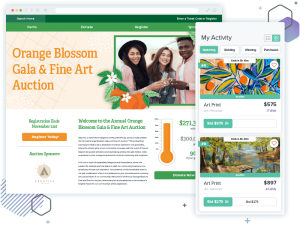As a nonprofit organization, you’re doing your part to make the world a better place. Your cause matters to your staff, volunteers, donors, and those you serve. What you do likely also appeals to businesses. Many businesses have corporate sponsorship programs with funds set aside to support nonprofits. According to a study published on Statista, an online statistics company, corporations paid 65.8 billion dollars in corporate sponsorships worldwide in 2018. If your nonprofit hasn’t pursued corporate sponsorship for your programs, capital campaigns, or fundraising events, you’re leaving a lot of potential money on the table. Use these tips to get started asking for corporate sponsorships.
Put together a sponsorship proposal
The first step to securing corporate sponsorships is to wow businesses with a stellar sponsorship proposal. Without an effective proposal, it’s unlikely that you’ll have luck recruiting sponsors to support your organization. Your proposal must include certain elements to ensure it’ll be given fair consideration by sponsorship request reviewers.
Start with a story
Giving is still an emotional act even if you’re dealing with a business. The story you tell should show the importance of the work your nonprofit does. Focus on stories that show the impact of your work. This story should be told from a beneficiary’s point of view. If your nonprofit helps animals, protects the environment, or otherwise lacks a direct human impact, tell the story for them. Otherwise, offer a first-person perspective from someone you served. These stories make an emotional connection with the reader and makes them more likely to support your organization.
Introduce your organization and mission
The next section of the sponsorship proposal is also a crucial piece to include in your proposal. You absolutely must introduce your nonprofit and its mission. The person reviewing your sponsorship request may be unfamiliar with your organization. Even if it’s a local business, the specifics of your nonprofit may be unknown. Share your mission, a brief history, and information on the programs and services your nonprofit offers. Many reviewers are involved with marketing the business. If your nonprofit serves specific demographics, share that information as well. This may help the business see the value of supporting your programs, services, and events.
Share benefits of sponsorship
Nonprofits will be particularly interested in this section of your sponsorship proposal. The benefits section is where you can share how sponsoring your organization will benefit the business. Are you offering naming opportunities for sponsorships over a certain level? Will you post their logo and business name on your website? Include the businesses that sponsored the program or activity in your official program communications? Will event sponsors be given an exhibitor’s table at your event? Are you including their name on the event banners, merchandise, and event programs? Will your organization write a press release about the sponsorship? Which demographics will your sponsors be in front of if they support you?
Include a menu of sponsorship pricing
If you take nothing else away from this it should be this: companies don’t want to guess how much sponsorships cost. You know the projected annual costs of your programs and likely have a target sponsorship amount for your events. Create sponsorship levels that reflect your costs. If you know that a program costs $100,000 a year to implement, you could seek a single program sponsor (you’d have to target a pretty large company), or start with a sponsorship level of $10,000 and try to acquire ten of these sponsors. Make sure the benefits offered support the investment of those funds. You can offer lower giving levels but be sure to decrease the benefits as the dollar amounts decrease.
If you’re seeking funds for a new building, try to secure sponsorship in exchange for a naming opportunity. Businesses take advantage of naming opportunities to support nonprofits and improve their brand image. However, to qualify to have the building named after them, the company should pay a large portion of the construction costs. In this case, you don’t want a menu of prices in exchange for a building named after the business. You do, however, want to name a specific dollar amount for the opportunity and stick with it.
When it comes to event sponsorships, determine your projected event costs. You can create sponsorship levels with varying benefits or ask corporations to sponsor specific aspects of the event. You could have a refreshment sponsor, entertainment sponsor, a venue sponsor, etc. Just be sure the cost of sponsorship meets or exceeds your projected costs.
Courting prospective sponsors
Once you’ve developed a stellar sponsorship proposal, the next step is reaching out to businesses you’re seeking sponsorship from. Avoid reaching out via email or using an online “contact us” form unless that’s the official request of the business (often true of larger corporations). You’re asking a company to invest funds in support of your organization. Striking up a partnership like this should be a conversation.
Start with a phone call
Call and ask for the marketing or public relations department. These departments are most likely going to know which staff member reviews sponsorship proposals. During the call, introduce yourself, explain the reason for your call, and ask for a meeting to discuss the details. If they agree to a meeting, be sure to add it to your calendar.
Meet with potential sponsors
The meeting is your opportunity to make a great impression and sell the benefits of supporting your nonprofit. That means you need to be either on time or early, look professional, and ready to present your proposal and answer follow-up questions. Regardless of their decision, you’ll want to send a thank-you note to the reviewer for their time and consideration of your request. Even if your initial request was rejected, say thanks. Saying thanks helps you keep the door open for future sponsorships. If they agree to the sponsorship, that’s even more of a reason to send a personalized note of thanks.
Stay in touch after receiving payment
After receiving the sponsorship funding, stay in touch with your sponsor. For instance, keep them informed of the steps you’re taking to honor your end of the agreement. Savvy businesses will hold your nonprofit accountable to the terms laid out in your proposal. Wow your corporate sponsors. Deliver what you promised before sponsors ask. If working with your organization is easy and rewarding, you can likely count on this company for future sponsorships.
Offer flexible payment options
If you’re seeking program funding or a naming opportunity with a high price tag, you may want to offer flexible payment terms for these corporate sponsorships. Companies on the fence about spending a large sum all at once may be swayed by the option to pay their sponsorship in quarterly or monthly installments (especially for six figure sponsorship deals).
You can easily offer these payment terms using an online donation form or via a pledge entered directly into your CRM. For instance, the company can sign up for a recurring donation charged automatically at the specified frequency from a tablet you bring to the sponsorship meeting. Or you can manually set up the pledge and apply payments as checks come in. If you’re processing manually, monitor when payments are received. Then, let the sponsor know you received their payment.
Conclusion
Develop better relationships with corporate sponsors and earn more corporate sponsorships by adhering to these best practices. Your corporate sponsorship proposal is the most important piece to develop. Take time to incorporate a story, your mission, a pricing menu, and sponsorship benefits into this proposal. Then, deliver what you promised your sponsors. Be easy to reach and communicate regularly with your sponsors. Lastly, offer your corporate sponsors easy ways to pay with flexible payment plans. If you make giving an easy, enjoyable process your sponsors will thank you with renewed commitments in the future.


